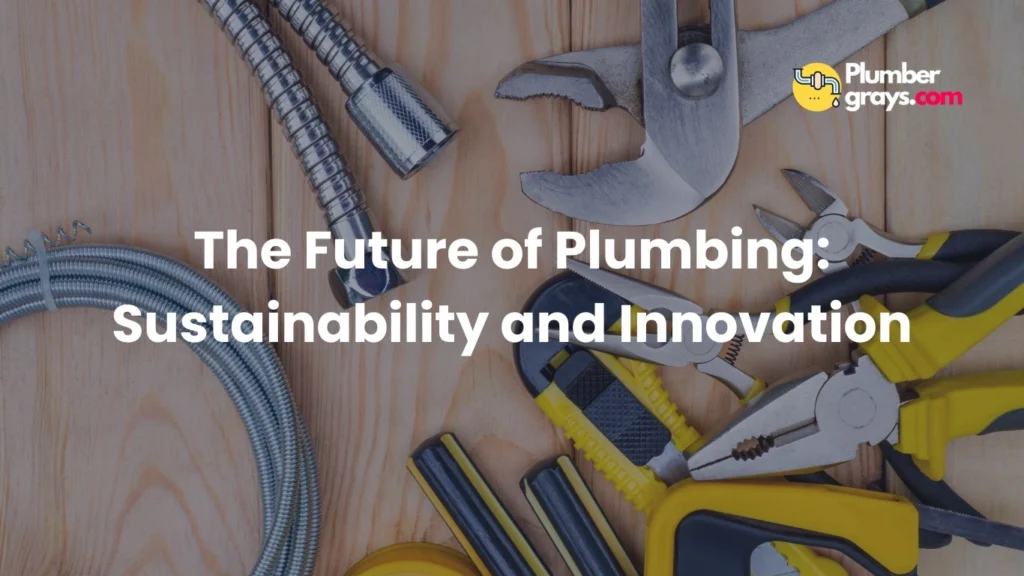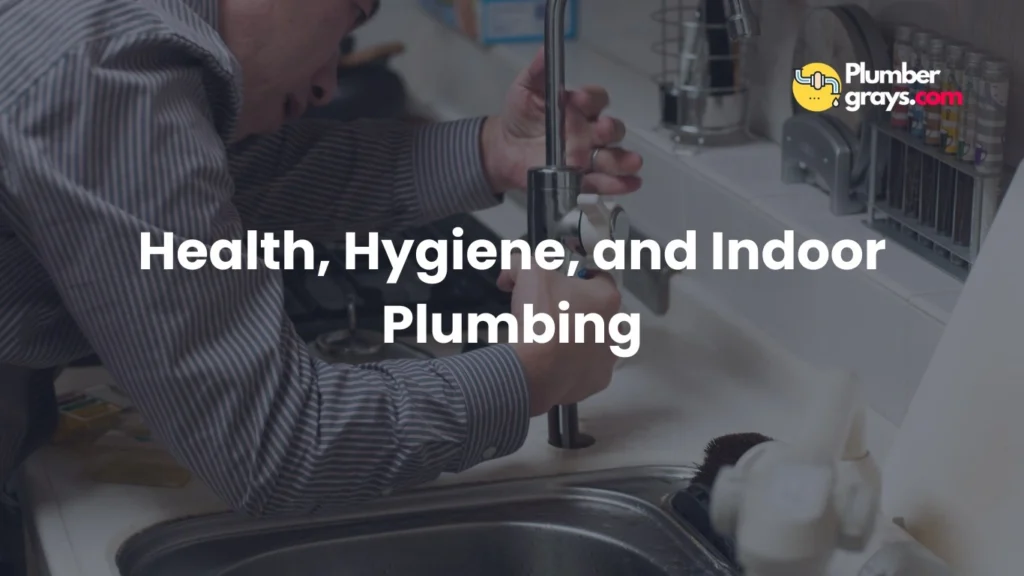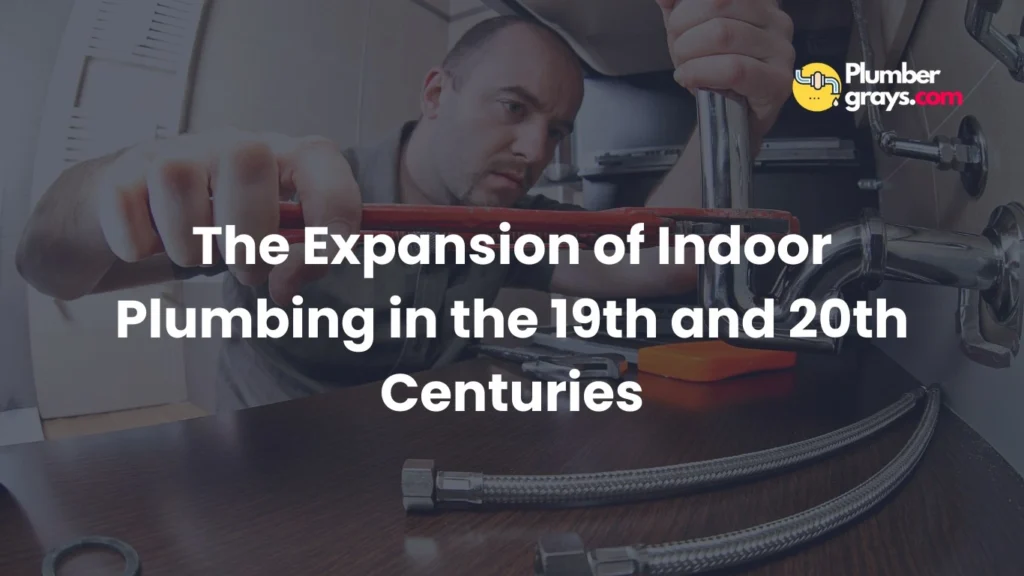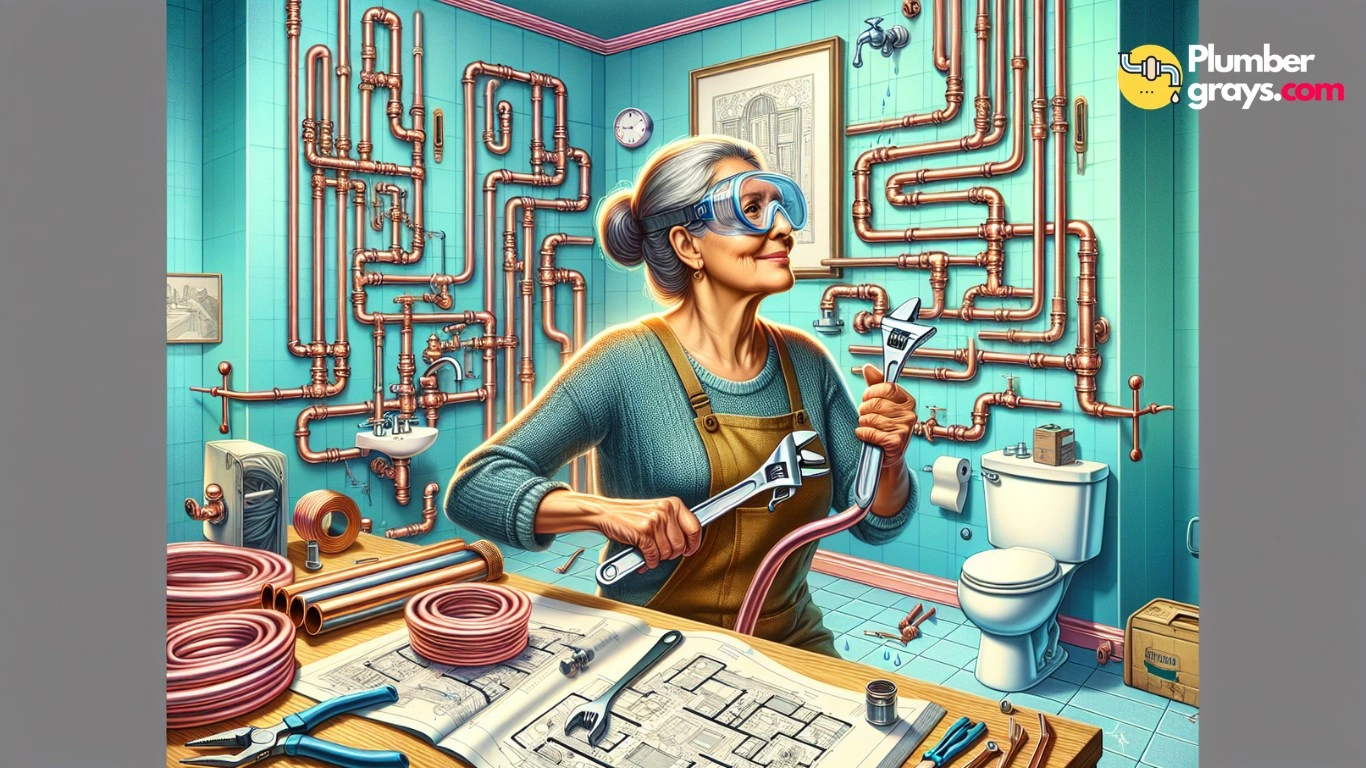Indoor plumbing, which revolutionized modern living when it was invented, ensures a continuous flow of fresh water into our homes and manages wastewater disposal with remarkable efficiency. The backbone of this system, a complex network of interconnected pipes, fixtures, and appliances, is crucial in preserving public health and water quality, thereby enhancing the well-being of both residential and commercial spaces—a testament to the rich indoor plumbing history. Beyond its core function, indoor plumbing plays a vital role in preventing water-borne diseases and contributes to cleaner air by implementing effective wastewater treatment and water purification processes.
The timeline of plumbing systems is dotted with significant milestones, including the introduction of durable materials like copper and ductile iron for water supply lines and the enforcement of strict local plumbing codes, which collectively mark when modern plumbing was invented. As we tackle the complexities of water management, facing challenges such as leaks and water pressure issues, the importance of regular maintenance becomes clear, serving as a key strategy to enhance the durability and performance of water supply systems. The future of plumbing is set to emphasize sustainability, with a growing focus on practices such as wastewater reuse, which aim to promote environmental health and resource conservation.
Significant Innovations in Plumbing Technology
The advent of innovations in Plumbing Technology has dramatically reshaped the modern form of water management and conservation in both homes and businesses, paving the way for more efficient and eco-friendly practices.
1. Water Heating and Conservation:
- Tankless Water Heaters: Incorporating heat pumps can save households $400 to $600 annually by efficiently heating water on demand, while also boasting an impressive lifespan of over 20 years.
- Hot Water Recirculation Systems: ensure instant hot water access, reducing waste.
2. Smart Plumbing Solutions:
- Smart Pipe Technologies: monitor systems for leaks, temperature, and humidity, offering emergency shut-off capabilities.
- Advanced Faucets and Smart Shower Heads: allow for voice or preset setting controls, enhancing convenience and water efficiency.
- Smart Water Heaters and Irrigation Systems: use data analytics for optimal operation, contributing to energy savings.
3. Hygiene and Maintenance: - Touchless Fixtures: like faucets and soap dispensers improve restroom hygiene and conserve resources.
- Smart Toilets: Modern garbage disposals feature overflow protection, incorporate water-saving technologies, and boast self-cleaning capabilities, with the industry’s market size projected to reach a staggering $12.9 billion by 2026.
- Trenchless Sewer Pipe Repair: offers a less invasive solution to sewer maintenance, preserving property integrity.
These technological advancements not only elevate the user experience but also contribute to environmental sustainability by optimizing water supply management and reducing overall energy consumption.
The Industrial Revolution and Modernization
The question of when was indoor plumbing invented takes us back to the Industrial Revolution, which catalyzed significant advancements in indoor plumbing, transforming urban environments and public health. For over a millennium, plumbing systems saw little change until the Enlightenment and the Industrial Revolution sparked a wave of innovation and modernization. The 19th century marked a pivotal era in the evolution of sewer systems, witnessing the emergence of comprehensive sewage and water supply networks. This development was propelled by rapid urbanization and the resulting expansion of cities, which required more sophisticated plumbing solutions to accommodate the burgeoning demands.
- Key Developments:
- Sewer Systems: The foundations for public health and sanitation systems began during the Enlightenment and became more structured in the 19th century, laying the groundwork for the modern sanitation infrastructure we rely on today.
- Water Supply Systems: The establishment of citywide public water supply systems, such as Boston’s in 1652 and Philadelphia’s Fairmount Water Works around 1815, exemplified early efforts to distribute water efficiently and ensure its safety for the burgeoning urban populations.
- Sanitary Reform; The transformation of urban sanitation during the Industrial Revolution, especially in Europe and North America, was not only a byproduct of industrialization but also stemmed from a pivotal shift in the understanding of disease causation. It was during this era that the question of when indoor plumbing became common began to find its answer, as the mass adoption of indoor plumbing systems significantly boosted public health and hygiene.
As the 20th century unfolded, the integration of modern plumbing systems within residential and commercial structures further cemented the Industrial Revolution’s enduring impact on indoor plumbing in America, showcasing a commitment to improved living standards.
Challenges and Solutions in Urban Plumbing
In the United States, urban indoor plumbing systems, especially in densely populated metropolises like New York, encounter numerous challenges that require cutting-edge solutions. The aging infrastructure in many buildings leads to corrosion, leaks, and a decline in water quality, posing a formidable obstacle to preserving the integrity of essential water supply and sewage disposal systems. The complexity of water supply management is heightened in high-rise buildings, which must contend with issues such as ensuring adequate water pressure, efficient drainage, and the prevention of pipe leaks. Additionally, the compact nature of urban environments amplifies the risk of clogged drains and sewer backups, along with the challenge of maintaining a consistent hot water supply. These issues can lead to not just inconveniences but also the potential for significant property damage, making drain cleaning a critical service in such areas.
Read Also: The Best Hiller Plumbing Heating Cooling & Electrical Services
Solutions to Common Urban Plumbing Challenges:
- Aging Infrastructure: Proactive measures such as regular inspections and maintenance are key to mitigating the effects of aging pipes on the water supply, and when renovations occur, choosing materials that are resistant to corrosion and wear is crucial for long-term infrastructure health.
- High-Rise Challenges: In the context of high-rise buildings, the installation of pressure-regulating valves and ensuring proper venting are strategic measures that can effectively tackle issues related to water pressure and drainage, thereby enhancing the overall water supply system.
- Clogged Drains and Sewer Backups: Regular maintenance, including frequent cleaning and the innovative use of trenchless sewer repair technology, can effectively prevent and resolve common issues in the sewerage system with minimal disruption.
The strategic integration of smart technology into plumbing systems is a forward-looking solution that promotes indoor air quality. It enables real-time monitoring and a swift response to potential problems, ensuring urban plumbing networks are well-equipped to adapt to the evolving demands of city landscapes.
The Future of Plumbing: Sustainability and Innovation

Plumbing industry leaders are navigating towards a modern form of sustainability and innovation. They are dedicated to crafting water-efficient systems and enhancing the customer experience with cutting-edge technology.
Key Innovations and Sustainable Practices:
- Energy-Efficient Systems: The adoption of low-flow toilets, faucets, and showerheads is revolutionizing the water supply in homes, significantly reducing water consumption and utility bills.
- Smart Plumbing Technologies:
- Innovative real-time data monitoring for water usage and leak detection in water supply systems enables automatic shutoff features to prevent wastage, marking a significant step towards resource conservation.
- Integration with smart home devices for voice-activated control, providing convenience and promoting water conservation.
- Advanced Water Heating Solutions: Energy-efficient solutions like tankless and heat pump water heaters are becoming increasingly popular, offering instant hot water and reducing energy usage with the advanced technology of heat pumps.
Environmental Responsibility and Material Innovations: - Sustainable Materials: The use of environmentally friendly materials such as PEX and recyclable metals in plumbing installations contributes to more sustainable indoor heating systems, minimizing the environmental footprint.
- Water Recycling: Contemporary buildings are increasingly integrating greywater recycling and rainwater harvesting systems, making wastewater reuse an essential skill for plumbers well-versed in these eco-friendly technologies.
Regulatory Impact and Training Initiatives: - Since the U.S. Energy Policy Act’s inception, there has been a legislative thrust towards water conservation, including mandates for reduced water-flow rates and the adoption of low-flush toilets, which begs the question: when did indoor plumbing start?
- The indoor plumbing timeline is evolving as increased investment in apprenticeship programs is dedicated to preparing a new wave of plumbers with the competencies needed for the intricacies of modern, sustainable plumbing systems.
With a focus on water supply sustainability and adapting to consumer demands, the plumbing industry’s concerted efforts are set to tackle the twin challenges of water conservation and the ever-changing market requirements.
The Evolution of Modern Plumbing Systems
The history of indoor plumbing is a remarkable narrative of human innovation, tracing a path from the sanitation efforts of ancient civilizations through to the technological breakthroughs of the 19th century, each period making a pivotal contribution to the evolution of indoor plumbing.
- Ancient Beginnings:
- The Indus Valley Civilization, dating back to around 2600 BCE, is recognized for establishing some of the earliest indoor plumbing systems, complete with brick-lined sewers and communal bathing facilities.
- Mesopotamia is credited with inventing sewers and pioneering the first sanitation systems for the elite around 3000 BCE, which included the luxury of separate bathrooms and indoor toilets.
- Rome’s aqueducts, a marvel of ancient engineering, demonstrated their prowess by harnessing gravity sewer principles to transport freshwater over 57 miles daily between 510-31 BCE.
- Evolution of the Water Closet:
- The evolution of the water closet, from its early conical-shaped hopper to the efficient siphonic closet developed by Col. George E. Waring, Jr., represents the origins of the first indoor plumbing systems.
- Pioneering American innovation was crucial in the realm of indoor plumbing in America, with skilled potters replicating and refining English designs for plumbing fixtures and valves.
- Technological Advancements:
- By the late 19th century, the question of when was plumbing invented was answered as American manufacturers began to outpace competitors, showcasing a significant leap in plumbing technology and production capabilities.
- The siphonic closet’s widespread adoption, due to its superior flushing mechanism, was a defining moment in the timeline of when indoor plumbing became common, revolutionizing modern sanitation.
The indoor plumbing history is marked by a progression from rudimentary sewage disposal to advanced plumbing systems, highlighting the critical role of innovation in boosting public health and hygiene over time.
Health, Hygiene, and Indoor Plumbing

The widespread adoption of indoor plumbing, initiated by those who began public health and sanitation systems, has been instrumental in enhancing public health and hygiene, drastically reducing the prevalence of waterborne diseases and elevating sanitary conditions. The evolution of modern plumbing systems has been transformative, offering not just convenience but also a critical role in sewage treatment, which is essential for disease prevention and the promotion of hygiene practices.
Key Impacts of Indoor Plumbing on Health and Hygiene:
- Disease Prevention: Sewage systems have been instrumental in preventing diseases like dysentery, cholera, and typhoid fever. By ensuring access to clean drinking water and efficient waste disposal, these systems significantly minimize the risk of disease spread.
- Sanitation Facilities: The presence of sewer systems, including toilets and latrines, is crucial for appropriate waste disposal, preventing environmental contamination, and reducing the risk of disease transmission. Access to these facilities is essential for sustaining public health.
- Global Health Security: Sustainable sanitation and biological treatment processes are vital in curbing the spread of infectious diseases, such as COVID-19, cholera, and typhoid. Plumbing systems are at the forefront of providing these facilities, thereby bolstering global health security.
Despite significant advancements, about 2.4 billion people still lack access to toilets, and 663 million are without clean drinking water, highlighting the persistent challenges in achieving universal access to basic sanitation and sewage farms. The imperative for ongoing innovation and investment in wastewater technologies and plumbing infrastructure is clear, as it remains paramount to address disparities and enhance public health outcomes.
Roman Ingenuity and the Expansion of Indoor Plumbing
The Roman Empire’s advancements in indoor plumbing set a high benchmark for future civilizations in both scale and sophistication. Their achievements, which some might argue laid the groundwork for who invented indoor plumbing, can be categorized into three main areas.
1. Infrastructure and Innovation:
- The inception of the underground sewers, known as the Cloaca Maxima, dates back to between 800 and 735 B.C., highlighting Rome’s pioneering efforts in sanitation infrastructure. By 100 A.D., Romans had pioneered the integration of indoor plumbing into their homes, marking the beginnings of when plumbing started, complete with the opulence of hot and cold running water.
- The advent of lead pipes was a game-changer for their plumbing system, creating an extensive indoor plumbing network by the 1920s that served urban residents even hundreds of kilometers away. Despite these luxurious advancements for affluent Romans, the sewage treatment infrastructure also sustained public bathhouses and latrines, catering to the sanitation needs of the general populace.
2. Water Supply and Sewage Disposal: - An elaborate network of eleven aqueducts, developed over five centuries, channeled freshwater throughout Roman lands, distinguishing the public water supply from wastewater to preserve hygiene.
- These aqueducts, such as the Aqua Appia and Aqua Marcia, were predominantly gravity-based systems, showcasing the Romans’ sophisticated grasp of engineering and water management principles.
3. Public Health and Social Aspects: - Public latrines, colloquially termed ‘rooms of the easement,’ were seamlessly integrated into the sewerage system, providing a communal facility frequented by citizens across the social spectrum.
- The Romans’ pioneering approach to wastewater reuse, utilizing recycled water from public baths to flush latrines, stands as an early testament to recycling and sustainable water management.
These elements underscore the Roman Empire’s exceptional fusion of engineering, public health, and social utility within their plumbing systems, establishing foundational principles that have shaped the indoor plumbing timeline up to the present day.
Current Trends and Innovations in Plumbing
Embracing the future of plumbing necessitates a deep comprehension of the modern forms and innovations that are currently steering the industry’s path. These advancements are meeting the increasing consumer demand for high-tech home solutions while simultaneously addressing pressing environmental issues.
Smart Plumbing Innovations:
- Smart Technology Integration: Homeowners are on the lookout for high-tech solutions, and while smart plumbing fixtures like touchless digital faucets and smart water heaters are surging in popularity due to their convenience and efficiency, integrating air conditioning systems remains a separate but equally important consideration for modern home comfort.
- Brain Pipes Technology:A groundbreaking development in home maintenance, brain pipes technology, which could be complemented by advanced air filters, detects leaks within plumbing systems and promptly notifies homeowners, thus averting water loss and protecting against property damage.
Sustainability and Efficiency: - Greywater Systems: The trend of wastewater reuse is gaining momentum with the adoption of greywater plumbing systems, which empower homeowners to repurpose wastewater for tasks such as landscaping and flushing toilets, drastically cutting down on freshwater use and diminishing utility expenses.
- Water Conservation Features: Contemporary plumbing has evolved to incorporate water-conserving features like touchless faucets, voice-activated controls, and mood lighting, all of which not only elevate the user experience but also champion sustainable water usage, akin to the benefits provided by water filtration systems.
Industry and Communication Trends: - Digital Marketing:For plumbing businesses, the integration of digital marketing strategies has become indispensable, particularly when it comes to enhancing indoor air quality. By focusing on cultivating online reviews and leveraging email communication, these businesses are building a robust customer base in a highly competitive market.
- Mobile-First Communication:To boost employee satisfaction and productivity, plumbing businesses are emphasizing text messaging and work-based social media, adapting to generational changes in communication preferences. These modern approaches are also indirectly beneficial for promoting services like duct cleaning.
These trends highlight the plumbing industry’s pivot towards embracing technology and sustainability, including heating repair services, intending to meet the evolving needs of consumers and tackle environmental challenges.
The Expansion of Indoor Plumbing in the 19th and 20th Centuries

The expansion of indoor plumbing during the 19th and 20th centuries, a period when running water was invented, marked a significant advancement in public health and domestic convenience. This era was characterized by remarkable technological and infrastructural developments, revolutionizing the accessibility and functionality of indoor plumbing.
- Historical Milestones:
- Early Innovations: The semi-modern flushing toilet, developed for Queen Elizabeth I in 1596, laid the foundation for future plumbing innovations and can be considered one of the early examples of the first indoor plumbing.
- Patent and Paper: Alexander Cummings received the first patent for a flushing toilet in 1775, and by 1850, toilet paper became available. These milestones were significant advancements in personal hygiene and pivotal moments in the history of when plumbing was invented.
- Widespread Accessibility: By the 1800s, indoor plumbing began to be more widely available in households, with notable installations at The Tremont Hotel in Boston in 1829 and The White House in 1833, signaling the era when indoor plumbing became common.
- Infrastructure Developments:
- The Croton Aqueduct System (1842): This infrastructure not only supplied New York City buildings with a reliable water supply but also showcased the potential for sophisticated urban water management systems.
- Residential Adoption: By 1850, the question of when was indoor plumbing common started to get its answer as wealthier residents began integrating bathrooms and toilets into their homes, marking the rise of indoor plumbing standardization.
- Ancient to Modern Transition:
- The earliest indoor plumbing can be traced back to the first flushing water closet, which emerged between 1500 and 1000 B.C. in Crete, illustrating the extensive history and gradual evolution of plumbing systems into the modern age.
Tracing the indoor plumbing history reveals these advancements as pivotal in the shift from luxury to necessity, cementing indoor plumbing as a cornerstone of modern living and public health standards.
- The earliest indoor plumbing can be traced back to the first flushing water closet, which emerged between 1500 and 1000 B.C. in Crete, illustrating the extensive history and gradual evolution of plumbing systems into the modern age.
Challenges and Developments in the 21st Century
The indoor plumbing timeline is marked by addressing challenges and developments in the 21st-century plumbing industry, underscoring the importance of education and workforce development. The sector is renowned for its employment prospects, integral to economic growth and financial stability, particularly in several key areas:
- Employment and Economic Contribution:
- As a testament to indoor plumbing in America, the plumbing industry stands as a significant employer, offering jobs to millions and bolstering economic stability and growth.
- Educational Advancements:
- Institutions like FITI Schools are revolutionizing the industry, credited with nurturing a new generation of plumbers who might one day be compared to those who invented sanitation systems. These schools promote creativity, and forward-thinking, and instill a strong sense of responsibility in their students.
- Technological Preparedness:
- Students at these institutions are not only versed in traditional plumbing techniques but are also at the forefront of integrating sewage treatment innovations into their skill sets. Their education in the latest technologies ensures they can tackle the demands and challenges of 21st-century infrastructure with expertise.
These facets underscore the industry’s adaptation to contemporary challenges, highlighting a modern form of workforce development and technological integration that secures its relevance and resilience in today’s world.
- Students at these institutions are not only versed in traditional plumbing techniques but are also at the forefront of integrating sewage treatment innovations into their skill sets. Their education in the latest technologies ensures they can tackle the demands and challenges of 21st-century infrastructure with expertise.
Conclusion
Our comprehensive exploration has taken us through the history of indoor plumbing, showcasing its evolution from ancient times to the forefront of today’s innovations. This journey emphasizes plumbing’s crucial role in public health, convenience, and environmental sustainability. The advancements in water heating, smart technologies, and hygiene practices not only improve user experiences but also contribute to ecological preservation by reducing water and energy waste.
The future of the plumbing industry is shaped by a dedication to sustainability and technological advancement, addressing contemporary challenges and adapting to society’s changing needs. The push for energy-efficient systems and smart plumbing solutions, intertwined with the indoor plumbing history, signals a commitment to environmental stewardship and an improved quality of life.
FAQs
How can I obtain the plumbing blueprint for my home?
To obtain your house’s plumbing blueprint, you have several avenues to explore. If your home is relatively new, reaching out to the builder or contractor might yield the rough-in plumbing diagram, as they often retain these records. For older residences, the local county clerk’s office could have archival documents, potentially revealing when indoor plumbing was invented for your home. If these options fail, enlisting a plumber to draft a new diagram is always a viable solution.
What are the typical components included in plumbing plans?
Plumbing plans meticulously outline the infrastructure for efficient water delivery and waste removal, including sewer systems. These detailed schematics cover everything from water supply lines to waste drain lines, vent pipes, valves, and fixtures such as toilets and sinks.
What does a plumber’s work schedule usually look like?
A plumber’s average workday spans 8 to 10 hours, with their weekly schedule typically covering 4 to 5 days. This flexible arrangement can lead to a workweek of four ten-hour shifts, offering plumbers a three-day respite and an opportunity to reflect on the indoor plumbing timeline and its impact on their profession.
Can you provide a simple overview of plumbing?
The fundamentals of plumbing encompass a variety of critical components, including drain pipes, traps, and vents, which together constitute the Drain Water Vent (DWV) System. This intricate network is designed to efficiently channel water to the sewage systems, safeguard against the backflow of waste into residential spaces, and securely expel sewer gases to the building’s exterior.


Comments are closed